Are there any microcontollers on the market that would be able to drive this relay directly?
If not, what is the most cost effective way to have a microcontroller control 5 relays?
Are there any microcontollers on the market that would be able to drive this relay directly?
If not, what is the most cost effective way to have a microcontroller control 5 relays?
No uC (microcontroller) operates from 12V (except for 1 pin per uC for very niche application pins in a very few cases).
30 mA is more than the rated current from any uC
Drivers are easy and cheap.
5 x MOSFET. uC drives gate. Source grounded. Drain to rely. Relay to 12V. Reverse diode across relay. eg ZVN2106 [prices(http://search.digikey.com/us/en/products/ZVN2106A/ZVN2106A-ND/92596) and [datasheet]((http://www.diodes.com/datasheets/ZVN2106A.pdf)
Same with a bipolar transistor but needs a 1K base drive resistor uC to base. Emitter grounded. Collector to relay. etc
eg BC337 prices and datasheet
Circuit below same for FET or bipolar EXCEPT FET does not need base resistor.

No, none operate at 12V. Use five suitable BJTs.